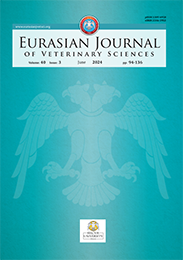| 2015, Cilt 31, Sayı 2, Sayfa(lar) 116-121 |
| [ Türkçe Özet ] [ PDF ] [ Benzer Makaleler ] |
| Identification and antimicrobial susceptibility of Corynebacterium pseudotuberculosis isolated from sheep |
| Aslı Sakmanoğlu1, Hasan Hüseyin Hadimli1, Osman Erganiş1, Yasemin Pınarkara2, Zafer Sayın1, Kürşat Kav1 |
| 1Department of Microbiology, Faculty of Veterinary Medicine, Selcuklu, Konya, Turkey 2Department of Food Technology, Sarayonu Vocational School, University of Selcuk, Sarayonu, Konya, Turkey |
| Keywords: Corynebacterium pseudotuberculosis, sheep, caseous lypmhadenitis, PCR |
| Downloaded:1842 - Viewed: 3128 |
|
Aim: The aim of this study was to identification of Corynebacterium
pseudotuberculosis (C. pseudotuberculosis) isolated from lymph node
of sheep with caseous lypmhadenitis (CLA) by biochemical characteristics
and confirmation by Polymerase Chain Reaction (PCR). Also,
phospholipase D enzyme activities and antimicrobial susceptibility of
isolates were determined.
Materials and Methods: A total of 1176 sheep were examined the presence of CLA, and 1176 of lymph node were collected for bacteria isolation. The samples were inoculated onto Blood Agar Base supplemented with 5% defibrinated sheep blood at 37ºC for 48 hours in microaerophilic atmosphere. Morphological and biochemical characteristic of C. pseudotuberculosis suspicious isolates were determined. PCR analysis was performed to confirmation of biochemical identification. Also, phospholipase D enzyme activities with Rhodococcus equi (R. equi) and Staphylococcus aureus (S. aureus) and antimicrobial susceptibility of isolates for 16 antimicrobial were determined by disc diffusion methods. Results: Totally of 72 C. pseudotuberculosis were identified according to biochemical characteristics. All isolates showed PLD enzyme activities antagonists with S. aureus and synergistically with R. equi. All isolates were confirmed by PCR as C. pseudotuberculosis. Isolates were determined to be sensitive to different antibiotics at different rates. The majority of the isolates were susceptible to florfenicol (98%), while ampicillin and lincomycin resistance was determined as 62.5%. Conclusions: Although there are many data related to the failure of the in-vivo treatment of CLA infection by antibiotics, C. pseudotuberculosis was determined as in-vitro sensitive to many antibiotics used in this study. PCR method and primers used in this study was determined very useful for confirmation of C. pseudotuberculosis identified by biochemical characteristic |
| [ Türkçe Özet ] [ PDF ] [ Benzer Makaleler ] |





